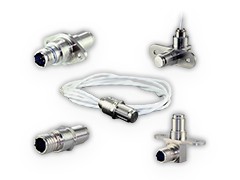Honeywell has two new platforms of proximity sensors: General Aerospace Proximity Sensors (GAPS) and Harsh Aerospace Proximity Sensors (HAPS), formerly known as the IHM Series. Both platforms incorporate Honeywell’s patented Integrated Health Monitoring functionality. However the products have some technical differences that allow them to be used in various aerospace applications. GAPS can be used in less harsh areas of application with some differences of electrical and environmental characteristics when compared to HAPS. Whilst, HAPS Aerospace Proximity Sensors are configurable, non-contact, hermetically sealed devices designed to sense the presence or absence of a target in harsh-duty aircraft applications.
Honeywell Next Generation Proximity Sensors: GAPS & HAPS

Features
- Industry-leading indirect lightning and dielectric ruggedness: Meets the increased requirements of today’s composite aircraft
- Enhanced vibration ruggedness: Capable of withstanding extremely high vibration applications
- Environmentally rugged: Fully hermetic packages provide long-term reliability in very harsh environments
- Hermetic package eliminating the potential for contamination of the sensor from the application environment.
- Integral Health Monitoring Capability: Optional third output state to indicate the health of the sensor (whether it is healthy or failed)
- Reduces maintenance time, reduces delayed flights, and lowers overall maintenance cost across the life of the aircraft
- Non-contact design: Utilizes noncontact technology to sense the presence or absence of a target regardless of the dirty, harsh environment
- Design eliminating mechanical failure mechanisms, reducing wear, minimizing downtime, increasing durability, and increasing reliability
- Value to Customers Hermetic sealing helps increase revenue (flight hours), reduce cost to serve (maintenance), reduce cost of goods (spares)
- Platform approach helps to increase revenue and reduce cost to serve
- Continuous Health monitoring helps to increase revenue, reduce cost to serve, and reduce cost of goods
- Supplier stability helps to reduce cost to serve (troubleshoot with original supplier)
- Current install base helps to reduce cost to serve (proven performance and MTBF 500,000)
- Enhanced vibration and EMI specifications help to increase revenue (flight hours) and reduce cost to serve (system maintenance)
Applications
GAPS
- Landing Gear
- Aircraft Doors
- Hydraulics
- Primary Flying Surfaces
- Rear Stabilizer
- General Actuators
- Airframe
- Rotary Actuators
- Evacuation Slides
- Cargo Storage
- Turbine Speed/ Air Condition Motors
HAPS
- Thrust Reverser Actuation Systems
- Valves
- Engine
- Actuators
- Nacelles
- Canopies
- Ground Vehicles
- Transportation
- Oil & GAS